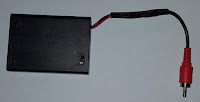The original light didn't work as well as I had hoped. The light fixture and mount were OK, but the connection to the battery pack was a failure. The ledge on the stand that they used would not accept the clip mount for the battery pack, and the 9volt connection seemed too confusing for them.
I found a 3 cell battery pack online with an on/off switch.
I connected the wire leads to an RCA plug and rewired the light with an RCA jack. Once the plug and jack were connected, the musician could just flip the switch.
The width of the pack fit perfectly into a section of the music stand pencil holder with a rubber liner glued into it.
The battery pack now sits at the top of the music stand close to the light.
I found a 3 cell battery pack online with an on/off switch.
I connected the wire leads to an RCA plug and rewired the light with an RCA jack. Once the plug and jack were connected, the musician could just flip the switch.
The width of the pack fit perfectly into a section of the music stand pencil holder with a rubber liner glued into it.
The battery pack now sits at the top of the music stand close to the light.



Comments
Post a Comment